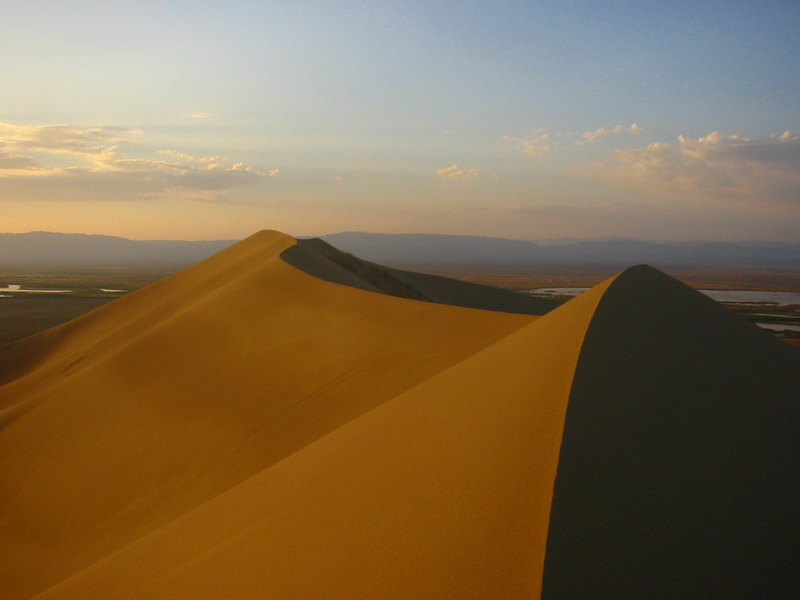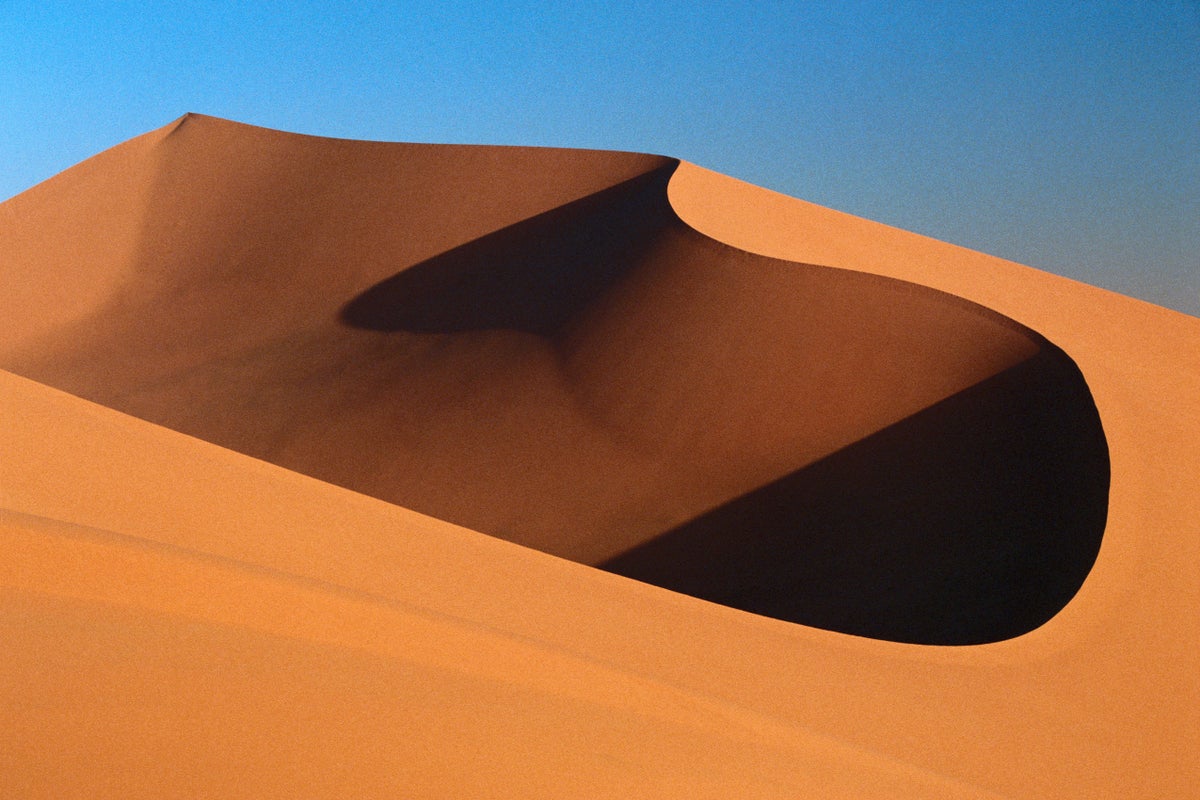Introduction to Singing Sand
Singing sand, also called whistling sand, barking sand, booming sand or singing dune, is sand that produces sound. The sound emission may be caused by wind passing over dunes or by walking on the sand.
Certain conditions have to come together to create singing sand:
- The sand grains have to be round and between 0.1 and 0.5 mm in diameter.
- The sand has to contain silica.
- The sand needs to be at a certain humidity.
The most common frequency emitted seems to be close to 450 Hz.

There are several theories proposed for the mechanism of singing sand. Some suggest that the frequency of sound is determined by the shear rate. Others propose that the frequency of vibration is due to the thickness of the dry surface layer of sand. This sound wave bounces from the surface of the dune to the surface of the moist layer with a resonance that amplifies the volume of the given sound. It could either be produced by friction among the grains or by compressing air between them.
It has been said that sand may also produce “roaring” or “booming” sounds.
Singing sand, also known as “booming sand,” refers to a fascinating natural phenomenon where sand grains produce a musical sound when disturbed, often described as a low-frequency hum, whistle, or even a boom. This rare and intriguing event occurs in various deserts and dunes across the world, capturing the imagination of those who experience it.
The sounds can vary in pitch, intensity, and duration, creating a mystical aura that has long been a subject of scientific research and cultural intrigue. While singing sand may seem like an enchanting myth or a mysterious anomaly, it has a well-documented explanation rooted in the physical properties of sand and the specific environmental conditions that allow such sounds to emerge.

The phenomenon of singing sand is most commonly observed in arid regions, where sand dunes, particularly large and stable ones, are abundant. Famous locations where this event can be witnessed include the dunes of the Gobi Desert in Mongolia, the Sahara in Africa, the Mojave Desert in California, and even some places in China and the Middle East. The particularity of the sand grains in these areas plays a crucial role in the creation of sound. The sand grains involved are typically round, smooth, and of a specific size range, allowing them to rub against one another in a way that generates vibrations audible to the human ear.
The mechanism behind the creation of sound lies in the interaction between the sand grains. When a layer of sand is disturbed, whether by wind or human activity such as walking or sliding down a dune, the grains of sand rub together and create friction. This friction causes a release of energy in the form of sound waves. Interestingly, the volume, pitch, and tone of the sound depend heavily on the size of the sand particles, their smoothness, and how they are packed. Grains that are too rough or too angular tend to create quieter, less distinct sounds, while smoother, rounder grains create clearer, more musical notes.

The scientific explanation behind the phenomenon suggests that the sound produced by the sand is a result of a resonance effect. When the sand is disturbed, the grains may align in such a way that they form a resonant structure. This structure can amplify the vibrations produced by the friction between the grains, creating a booming or musical sound.
In some cases, the sand dunes even create low-frequency sounds that resemble the deep tones of a drum or thunderclap. The right conditions are key, and not every sandy location will produce this effect. Factors such as moisture content, wind patterns, and the time of day can all influence whether the sand sings or remains silent.
Interestingly, the phenomenon of singing sand has long intrigued cultures across the globe. In some traditions, it is believed that the sound of the sand is a mystical or supernatural occurrence. In ancient Egypt, for example, some believed that the sounds emanating from the desert were the voices of spirits or gods. In other cultures, the singing sand was seen as a symbol of the desert’s vastness and mystery. Such cultural interpretations reflect the deep connection between human civilization and the natural world, particularly in regions where the desert is both a source of life and a place of myth.

Modern research on singing sand has led to a better understanding of the physical properties that make this phenomenon possible. Scientists have discovered that the exact frequency and type of sound produced depend on the angle at which the sand slopes, the level of moisture in the sand, and even the temperature. For instance, sand that is slightly damp can suppress the sound, as the moisture causes the grains to stick together, preventing the friction needed for vibration. Conversely, very dry sand is more likely to produce a strong and continuous hum when disturbed.
While the phenomenon of singing sand may seem like a small curiosity, it holds significant importance for the study of geology, acoustics, and the natural environment. It offers insights into the physical properties of sand and how environmental factors can shape the way materials interact. Moreover, understanding this phenomenon contributes to a broader understanding of desert ecosystems, helping scientists learn more about the conditions that allow life to thrive in such extreme environments. It also serves as a reminder of the natural world’s ability to surprise and delight with its hidden wonders.
In the dunes
Singing sand dunes, an example of the phenomenon of singing sand, produce a sound described as roaring, booming, squeaking, or the “Song of Dunes”. This is a natural sound phenomenon of up to 105 decibels, lasting as long as several minutes, that occurs in about 35 desert locations around the world. The sound is similar to a loud low-pitch rumble. It emanates from crescent-shaped dunes, or barchans. The sound emission is associated with a slumping or avalanching movement of sand, typically triggered by wind passing over the dune or by someone walking near the crest.
Examples of singing sand dunes include California’s Kelso Dunes and Eureka Dunes; AuTrain Beach in Northern Michigan; sugar sand beaches and Warren Dunes in southwestern Michigan; Sand Mountain in Nevada; the Booming Dunes in the Namib Desert, Africa; Porth Oer (also known as Whistling Sands) near Aberdaron in Wales; Indiana Dunes in Indiana; Barking Sands Beach in Hawaiʻi; Ming Sha Shan in Dunhuang, China; Kotogahama Beach in Odashi, Japan; Singing Beach in Manchester-by-the-Sea, Massachusetts; near Mesaieed in Qatar; and Gebel Naqous, near el-Tor, South Sinai, Egypt.

The song “The Singing Sands of Alamosa” on Bing Crosby’s 1947 album Drifting and Dreaming was inspired by the sand dunes near Alamosa, Colorado, now Great Sand Dunes National Park.
Some Mysteries related to Singing Sand
1. What Causes Sand to “Sing” in Desert Dunes?
Singing sand, also known as “booming sand,” is a mysterious phenomenon that occurs when sand grains create musical sounds when they are disturbed, such as by wind, movement, or footsteps. Scientists believe that the sound results from the friction between the grains, causing them to vibrate at a certain frequency.
This happens when the sand grains are round and uniform in size, which allows for the smooth interaction necessary for this eerie music to emerge. The sound is typically a low-frequency hum or boom, and it can travel over long distances in the desert, making it an otherworldly experience for those who encounter it. However, not all deserts produce singing sand, and the reasons behind the phenomenon’s occurrence are still not fully understood.
The mystery lies in the factors that allow this sound to happen. One key theory is that when the sand is disturbed, a layer of dry grains on the surface slides over another layer of grains underneath. The friction between these layers creates vibrations that resonate and amplify, producing a sound that resembles a musical tone. Scientists are still studying how the precise combination of grain size, shape, moisture, and wind speed contributes to the exact nature of the sound produced. While some researchers have suggested the frequency of the sound corresponds to the size of the grains, others argue that the mineral composition of the sand may play a crucial role.
In some rare instances, the sound can even be triggered by walking on the sand, with each step releasing a burst of energy that produces a brief sound. In the absence of wind, the booming sand becomes even more mysterious because it appears to be coming from the ground itself. Despite these theories, the phenomenon still eludes complete scientific explanation, leaving room for wonder and speculation.
2. Where Can Singing Sand Be Found?
Singing sand can be found in various regions across the globe, though the phenomenon is most commonly associated with arid deserts and sand dunes. Some of the best-known places where the sound can be heard include the deserts of China, the Sahara, the Atacama Desert in Chile, and parts of the United States, such as California’s Death Valley. The sand dunes in these regions, particularly those with well-rounded, uniform grains of sand, are more likely to produce the “singing” effect.
For example, the Namib Desert in Namibia is famous for its “singing dunes,” which emit low-frequency booming sounds when the wind blows or people walk on them. The Great Sand Dunes National Park in Colorado, USA, is another location where people can hear the mysterious sounds of the sand. While these locations are popular, there are many other lesser-known places where the singing sands can be heard, depending on the environmental conditions.
Interestingly, not all sand dunes in these regions produce the sounds. The specific combination of sand particle size, moisture, temperature, and even the wind’s velocity must align just right for the “singing” effect to occur. This makes the exact locations where the phenomenon happens somewhat unpredictable, and it adds to the mystique surrounding it.
3. Why Do Some Sands Sing and Others Don’t?
The reason why some sand dunes produce music while others remain silent is tied to a complex set of physical and environmental conditions. For sand to sing, it must have specific properties. The size of the grains, their smoothness, and uniformity are all critical factors. Most singing sands consist of quartz grains that are roughly the same size, between 0.1 and 0.5 millimeters in diameter. These grains are often well-rounded, making them smooth enough to slide over each other easily.
Moisture is another important factor. Dry sand tends to be more likely to produce the singing sound, whereas moist sand doesn’t have the same friction between the grains, preventing the vibrations needed for the sound. The exact moisture content required for the sound to occur varies, but it is typically a very fine balance—too little moisture, and the grains won’t slide; too much, and the friction is reduced.
Wind also plays a crucial role in amplifying the sounds of the singing sand. A strong wind can help move the sand grains, creating the necessary friction and resonant frequencies. However, in some cases, it has been reported that the sound can be triggered simply by walking or sliding an object across the surface, suggesting that the sand’s structure itself is enough to make the sound emerge in the right conditions.
4. Is the Sound of Singing Sand Harmful or Dangerous?
Despite the eerie nature of the sounds that emanate from the sand, there is no evidence to suggest that the phenomenon is harmful or dangerous to humans. The sound itself is typically low-frequency, and while it may sound like a distant thunderstorm or an approaching aircraft, it poses no physical threat. However, there have been occasional reports of people feeling disoriented or uncomfortable when exposed to prolonged exposure to the booming sounds, particularly in areas where the frequency is strong and constant.
In some cultures, the sound of singing sand has been associated with omens or supernatural beliefs. For instance, in certain Middle Eastern cultures, the booming noise was sometimes thought to signal an impending sandstorm or other natural events. Today, however, scientists understand that it’s a natural phenomenon caused by the vibrations of sand particles and not a precursor to any disaster.
Despite its lack of harm, some people may find the sound unsettling or disorienting, particularly because it can seem like it’s coming from nowhere. That said, the mystery surrounding the phenomenon only adds to its intrigue, attracting adventurers, scientists, and tourists eager to experience it firsthand.
5. Can Singing Sand Be Used in Musical Instruments?
Although the sounds produced by singing sand are natural, scientists have wondered whether the phenomenon can be harnessed for musical purposes. While the idea of creating musical instruments using sand sounds may seem far-fetched, some researchers have considered how the sound vibrations could be used in unique instruments. The tonal quality of singing sand is influenced by the size, shape, and frequency of the sand particles, so it might be possible to recreate these sounds in a controlled manner.
For example, in some experiments, researchers have recreated the sound of singing sand using mechanical systems that replicate the friction between sand grains. By adjusting the setup of the sand, it may be possible to produce musical notes or even use the natural frequencies in compositions. However, capturing and sustaining the precise sound of singing sand would require advanced technology to replicate the exact environmental conditions that trigger the phenomenon.
Currently, there are no mainstream musical instruments that incorporate singing sand, but the idea of using it as a medium for sound exploration is still a subject of scientific interest. The potential for using natural phenomena like this to create unique acoustic experiences has led some to speculate about the future of sound-based technology.
6. How Have Different Cultures Interpreted the Singing Sand?
Across different cultures, the phenomenon of singing sand has been met with various interpretations, often linked to supernatural or mystical beliefs. In some ancient cultures, the sounds were considered omens or signs from the gods. For instance, in Arab folklore, the booming sound of sand was sometimes thought to signal an impending storm or disaster. It was believed that the “singing” sand could foretell a change in weather or the arrival of a sandstorm.
In other cultures, the sounds were seen as mysterious messages or a form of communication from the spirits. Some tribes in Africa and the Middle East believed that the sound was a message from their ancestors, warning them of impending danger or providing guidance. Similarly, in certain Native American traditions, the mysterious sounds of the desert sands were thought to be the voices of the earth itself, speaking to those who listened carefully enough.
The connection between sand and spirituality has also been explored in more modern contexts, with some people associating the sound of singing sand with meditative practices or rituals. The calming, repetitive nature of the sound can have a hypnotic effect, and it’s sometimes used in meditation and relaxation exercises. This suggests that, beyond scientific curiosity, the sounds of singing sand have a deeper, more personal significance for many individuals.
7. Could Climate Change Affect the Occurrence of Singing Sand?
Climate change may have an indirect impact on the occurrence of singing sand by altering the environmental conditions that allow it to happen. The phenomenon relies on specific combinations of temperature, wind, humidity, and sand composition. As the climate warms and weather patterns shift, the conditions that make sand sing could become more or less common, depending on the region.
For instance, changes in wind patterns could influence how sand dunes form and how often they are disturbed by natural forces. If wind patterns become less predictable or less intense, the conditions required to produce singing sand might be disrupted. Similarly, changes in rainfall could affect the moisture content of the sand, either preventing the formation of the right friction conditions or making it too wet for the sounds to occur.
In regions where sand dunes are affected by desertification—an increasingly common consequence of climate change—singing sand may become a rarer phenomenon. This is because the formation of stable, well-structured dunes that allow for sound generation may be disrupted. While more research is needed to understand the relationship between climate change and the occurrence of singing sand, it is possible that the environmental shifts caused by global warming could impact this mysterious phenomenon.
8. What is the Role of Wind in Singing Sand?
Wind plays a central role in producing the sounds of singing sand. When strong gusts of wind blow across a sand dune, the sand grains are disturbed, causing them to move and collide. This friction between the grains produces vibrations that resonate, creating the distinctive hum or booming sound. Wind helps amplify these vibrations by carrying the sound across large distances, making the effect more pronounced in open desert landscapes.
Interestingly, the intensity of the sound varies with the wind’s speed. A gentle breeze might create a soft, almost melodic hum, while strong gusts may generate deep, resonant booms. This variability in sound quality suggests that wind plays a vital role in not just triggering the sound but also influencing its tonal quality. As such, the combination of sand’s physical properties and wind’s movement is what makes singing sand possible, creating a unique and unpredictable auditory experience in the desert.
9. How Long Has the Phenomenon of Singing Sand Been Known?
The phenomenon of singing sand has been known to humans for centuries. Ancient cultures in desert regions were among the first to observe and interpret the strange sounds coming from the sand. The earliest written accounts of the phenomenon date back to around the 10th century, with mentions of the sounds appearing in Arabic literature. Travelers, explorers, and traders who ventured into desert regions like the Sahara and the Middle East were some of the first to describe the phenomenon, which they often linked to omens or supernatural occurrences.
Over time, the phenomenon became a subject of fascination for scientists, particularly during the 19th and 20th centuries when the fields of geology and acoustics began to develop. While ancient interpretations were often steeped in mysticism, modern scientists have been able to offer more logical explanations for the cause of the sounds, though the exact mechanisms are still being studied. Today, the singing sands continue to captivate the imagination of both researchers and the public, keeping the mystery alive.
10. Are There Any Modern Theories About Singing Sand?
While scientists have made strides in understanding the mechanics of singing sand, there are still several modern theories about the phenomenon. One leading hypothesis involves the vibration of the sand grains themselves. According to this theory, when sand particles of a certain size and shape are disturbed by wind or other forces, they generate vibrations that resonate, producing the booming or musical sounds.
Another modern theory suggests that the sound could be produced by the interaction between the sand and the surrounding environment. The dry, powdery surface of the sand may amplify the vibrations, while the acoustics of the surrounding landscape, such as the shape of the dunes or the presence of rock formations, could also play a role in how the sound is projected. This theory suggests that the landscape itself contributes to the acoustics of the sand, turning the desert into a giant, natural resonator.
Finally, some researchers believe that there may be an undiscovered biological or chemical element that influences the occurrence of singing sand. For example, microorganisms in the sand or traces of certain minerals might create conditions conducive to the vibrations needed to generate the sound. This speculative theory remains unproven, but it highlights the ongoing mysteries that still surround this captivating phenomenon.







 Let’s imagine, explore, and uncover the mysteries together!
Let’s imagine, explore, and uncover the mysteries together!